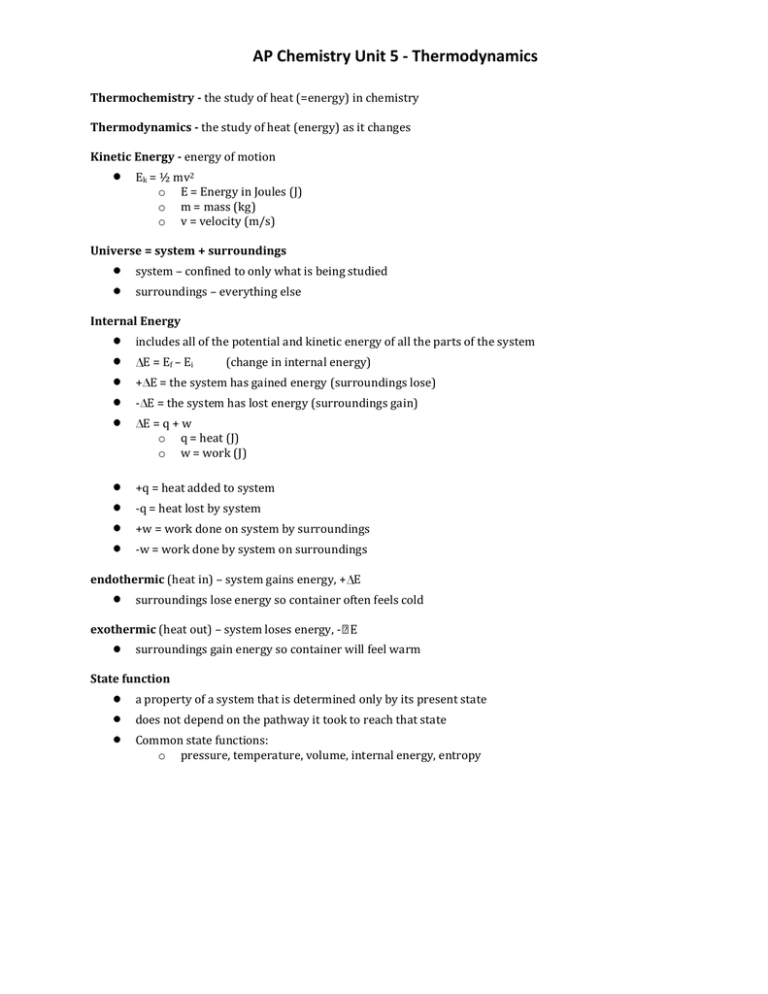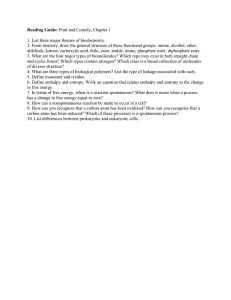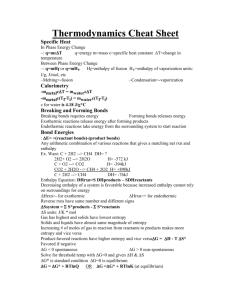AP Chemistry Unit 5
advertisement

AP Chemistry Unit 5 - Thermodynamics Thermochemistry - the study of heat (=energy) in chemistry Thermodynamics - the study of heat (energy) as it changes Kinetic Energy - energy of motion Ek = ½ mv2 o E = Energy in Joules (J) o m = mass (kg) o v = velocity (m/s) Universe = system + surroundings system – confined to only what is being studied surroundings – everything else Internal Energy includes all of the potential and kinetic energy of all the parts of the system E = Ef – E i (change in internal energy) + E = the system has gained energy (surroundings lose) - E = the system has lost energy (surroundings gain) E=q+w o q = heat (J) o w = work (J) +q = heat added to system -q = heat lost by system +w = work done on system by surroundings -w = work done by system on surroundings endothermic (heat in) – system gains energy, + E surroundings lose energy so container often feels cold exothermic (heat out) – system loses energy, surroundings gain energy so container will feel warm State function a property of a system that is determined only by its present state does not depend on the pathway it took to reach that state Common state functions: o pressure, temperature, volume, internal energy, entropy Enthalpy (H) heat flow H = E + P V (at constant pressure) o H = enthalpy (J) o E = internal energy (J) o PV = work done by changing pressure, volume (J) + H = system has gained heat - H = system has lost heat Determine the sign of H ice cube melting o + H (water gains energy to change from solid to liquid) 1 g of butane (C4H10) undergoes complete combustion o H (heat is released) What if the system is contained so no heat can be released? Will a piston rise or fall? o 2 C4H10 + 13 O2 8 CO2 + 10 H2O volume of products > volume of reactants o piston will rise to maintain a constant pressure Enthalpy of Reactions H = Hproducts - Hreactants enthalpy is an extensive property (depends on amount) enthalpy change for a reverse reaction will be the same in magnitude, opposite in sign enthalpy change depends on state of reactants and products How much heat is released when 4.5 g of methane gas is burned in a constant pressure system? ( Hrxn = -890 kJ) (-250 kJ) Calorimetry -measurement of heat flow heat capacity - the amount of heat required to raise the temperature of an object by 1K molar heat capacity - the amount of heat required to raise 1 mole of a substance by 1K specific heat - the amount of heat required to raise 1 g of a substance by 1 K s o o o o q m T s = specific heat (J/gK) q = amount of heat exchange (J) m = mass (g) T = temperature change (K) Constant Pressure Calorimetry How much heat is needed to warm 250 g of water from 22 (7.9 x 104 J) What is the molar heat capacity of water? (C = 75.2 J/mol K) A student mixes 50 mL of 1.0 M HCl and 50 mL of 1.0 M NaOH in a calorimeter and notices that the temperature rises from 21.0 C to 27.5 C. Calculate the enthalpy change if the total volume is 100 mL, the density is 1.0 g/mL, and the specific heat is 4.18 J/gK. (-2.7 kJ) Hess’s Law if a reaction is carried out in a series of steps, the H for the overall reaction will equal the sum of the enthalpy changes for the individual steps. Calculate H for Given o o o 2 C (s) + H2 (g) C2H2 (g) C2H2 (g) + 5/2 O2 2 (g) + H2O (l) C (s) + O2 (g) CO2 (g) H2 (g) + ½ O2 (g) H2O (l) H = -1299.6 kJ H = -393.5 kJ H = -285.8 kJ ( Hrxn = 226.8 kJ) Enthalpy of Formation Hf the amount of energy needed to form a 1 mole of a compound from its elements at standard conditions Note: Standard conditions here are 1 atm at 298 K o (vs. 1atm, 0 C for molar volume of a gas) What is the Hf for argon? 0! There is no formation of a compound. Which reactions are formations? 2 Na (s) + ½ O2 (g) Na2O (s) o yes 2 K (l) + Cl2 (g) 2 KCl (s) o no, K would be a solid under standard conditions two moles of product are formed K (s) + ½ Cl2 (g) KCl (s) C6H12O6 (s) 6 C (diamond) + 6 H2 (g) + 3 O2 (g) o No, decomposition o 6 C (graphite) + 6 H2 (g) + 3 O2 (g) C6H12O6 (s) Hrxn = Hproducts - Hreactants Calculate the enthalpy of reaction for the combustion of 1 mole of methanol (CH 3OH, -1367 kJ) Strength of Covalent Bonds Bond enthalpy – H for the breaking of a bond in one mole of a gaseous substance o Always positive o As H increases, bond strength increases o Generally, as the number of bonds between two atoms increases, strength increases and the bond length decreases Hrxn = ( Hbonds broken) - ( Hbonds formed) Estimate the enthalpy of reaction for the combustion of ethane (C2H6) gas. ( Hrxn = -1416 kJ) First Law of Thermodynamics Energy cannot be created or destroyed. Spontaneous process One that proceeds on its own without outside assistance The reverse reaction will be non-spontaneous Predict which are spontaneous… When a piece of metal at 150 o Spontaneous Water at room temperature decomposes into H2 and O2 gas. o Not spontaneous; reverse is spontaneous once ignited by a spark or flame Benzene (C6H6) vapor at 1 atm condenses to become a liquid at the normal boiling point. o Process is at equilibrium – neither forward or reverse reaction is spontaneous Entropy S (J/K) – the extent of randomness in a system Mercury is a silvery liquid at room temperature. The normal freezing point is -38.9 C, and its Hfus is 2.29 kJ/mol. What is the entropy change when 50.0 g of liquid mercury freezes at the normal freezing point? (-2.44 J/K (negative entropies tend to be non-spontaneous) Second Law of Thermodynamics Any irreversible process results in an overall increase in entropy, where as a reversible process results in no change in entropy. o i.e. The entropy of the universe is always increasing Entropy increases for… o Gases formed from liquids or solids o Liquids or solutions formed from solids o Reactions where there are more product gas molecules than reactant molecules Is S + or -? H2O (l) H2O (g) o positive Ag+ (aq) + Clo negative 4 Fe (s) + 3 O2 o negative 2O3 (s) N2 (g) + O2 o Need more information Third Law of Thermodynamics The entropy of a pure crystalline solid at 0K is 0. Entropy Changes in Reactions S = S products - S reactants Using Appendix C, calculate the change in entropy for the formation of ammonia gas from hydrogen and nitrogen gas. (-198.3 J/K) Gibbs Free Energy Determines the spontaneity of a reaction Exothermic reactions and those that increase in entropy tend to be spontaneous, but they could be competing factors (endothermic, increase in entropy) G= H-T S o G < 0, reaction is spontaneous o G > 0, reaction is not spontaneous (reverse rxn will occur) o G = 0, reaction is at equilibrium (btw. reactants & products) Effect of Temperature on Spontaneity of Reactions H S -T S G= H-T S Reaction Characteristics – + – – Spontaneous at all temperatures + – + + Non-spontaneous at all temperatures – – + + or – Spontaneous only at low T + + – + or – Spontaneous only at high T Using Appendix C, determine whether or not the reaction of forming ammonia gas from nitrogen and hydrogen gas is spontaneous at 25 C and at 500 . (-33.3 kJ, 61 kJ)






